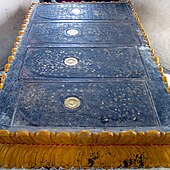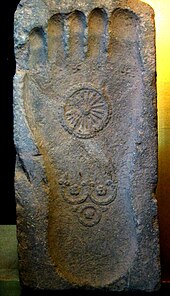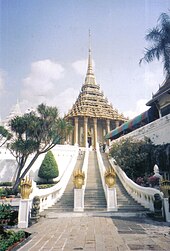Buddha's footprint
Buddha's footprint is a symbolic image of the Buddha . A Buddha's footprint comes in two forms: naturally as an indentation in rock, or figuratively as made by human hands.
A figurative footprint of Buddha was not created as a work of art, for decoration, or just to please the eye. Rather, the intention was to remind, teach, or perhaps even enlighten the viewer.
Footprints of the Buddha are very common all over Asia, he is an important part of the art traditions of the Theravada countries of Sri Lanka , Myanmar and Thailand . The Japanese author Motoji Niwa ( 丹羽 基 二 ) estimates that on his numerous travels across Asia he found around 3000 footprints, including 300 in Japan and over 1000 in Sri Lanka.

history
During the first centuries after the Buddha's death, he was never represented as a person, but only as a symbol. In the first century BC In Sanchi , northern India, the portals ( torana ) of the famous stupas were decorated over and over with symbols of the enlightened one by the descendants of the emperor Ashoka : the horse without a rider reminds of the farewell to his parents' house, the empty seat under the bodhi Tree to the moment of enlightenment, the stupas represent entry into nirvana . And there are footprints here, decorated with a round symbol in the middle. They simply represent the presence of the sublime.
Representations
On the soles of the feet of the Buddha the 32, 108 or 132 lucky symbols of the Buddha can almost always be seen, but they differ in almost all representations. But they all have one thing in common: in the middle there is always the Dharmachakra . A variety of figures can be seen around the Dharmachakra, some of which represent royal insignia , but some are also of mythological origin. Actually, one could say that the foot became a directory of mystical , mythological and cosmological ideas.
In summary, the 108 symbols and the Dharmachakra reinforce the viewer in the presence of the Buddha and his " message ". One recognizes the Buddhist cosmology and also the higher spheres into which one can be reborn. They can be also understood as a guide for monks, dedicated to Jhana - Meditation deal. One recognizes the individual stages that meditators can reach while perfecting themselves for the path to nirvana.
Thai readings
Virginia McKeen, in her article in the May 2003 issue of the National Museum Volunteers newsletter, suggested the following classification:
Early Burmese design
The oldest representation of a Buddha footprint with 108 symbols was found in the Lokananda Pagoda in Bagan , Myanmar . You start on a right foot with the counting on the top left with the symbol of the royal spear and then continue in a circular clockwise direction until you reach the middle, i.e. the Dharmachakra. The imprint of a left foot would be counterclockwise accordingly.
Sri Lanka design
In the Sri Lanka design, the 108 symbols are arranged in concentric circles around the wheel in the middle. You start in the middle at 12 o'clock again with the symbol of the royal spear and continue reading in a clockwise direction. An example of a Sri Lankan design footprint can be found at Wat Bowonniwet in Bangkok.
Thai design
In the case of footprints in Thai design, the realms of the 16 Brahmas with shapes and the six Deva realms are arranged in three horizontal lines at the top (below the toes) . Furthermore, with a left foot, reading is carried out line by line from left to right and from top to bottom. An example of this can be found on the feet of the great reclining Buddha in Wat Phra Chethubon ( Wat Pho ) in Bangkok.
Free design
There are also footprints in which the symbols are not arranged in a specific pattern, for example a wooden footprint about one meter high in the National Museum of Chiang Mai. The design is decorated with mother-of-pearl inlays and gold.

Design of the four buddhas
In the design of the four Buddhas, each of the last four Buddhas to appear in this Buddhist age, Dipamkara , Konagama , Kassapa and Gotama , left an imprint. The arrangement can be any of the above four designs. The sizes of the four prints are different due to the height of the four Buddhas. In the 5th century Madhuratthavilasini, the height of Kakusandha is given as 18.28 meters, that of Konagamana as 13.7 meters, Kassapa was 9.14 meters high and Gotama 8.23 meters. Therefore, of course, the size of the footprints is no longer surprising.
- File recordings of various symbols, Wat Pho
Dharmachakra, also Mount Meru
Indra's palace, which stands on Mount Meru. Here on the soles of the feet it is located above the Dharmachakra.
literature
- Henry Alabaster: The Wheel of the Law . Trübner & Co., London 1871 ( at Internet Archive ), reprinted by Kessinger Publishing, LLC, Kila, 1998. ISBN 0-7661-0426-5 .
- Claudio Cicuzza: A Mirror Reflecting the Entire World. The Pāli Buddhapādamaṅgala or “Auspicious signs on the Buddha's feet”. Critical edition with English Translation . (Materials for the Study of the Tripiṭaka, vol. VI) Lumbini International Research Institute, Bangkok (Thailand) / Lumbini (Nepal) 2011, ISBN 978-974-496-525-7
- Carol Stratton: Buddhist Sculpture of Northern Thailand . Silkworm Books, Chiang Mai 2004, ISBN 1-932476-09-1 .
- Jean Boisselier : The Heritage of Thai Sculpture . Weatherhill, New York 1972, ISBN 0-8348-0109-4 .
- ปื ยะ พร กัญ ชนะ: มณฑป พระพุทธบาท สระบุรี - สารานุกรม เมือง โบ ราน ( Mondop Phra Putthabat Saraburi ). กรุงเทพ เมือง โบ ราน ๒๕๔๐ (Muang Boraan Publishing, Bangkok 2540/1997), ISBN 974-7381-05-2 .
Web links
- The footsteps of the Buddha : Description of the individual mother-of-pearl images on the soles of the feet of the Phra Norn , the Great Reclining Buddha
- Description of Wat Phra Putthabat in Saraburi (with many photos) ( Memento from October 21, 2004 in the Internet Archive ) (in English)
- Bussokuseki, Stone Footprints of the Buddha (in English)
Individual evidence
- ^ Carol Stratton: Buddhist Sculpture of Northern Thailand , p. 301.
- ↑ Motoji Niwa: Buddha's footprints, pictures and explanations: Buddhism as seen through the footprints of Buddha ( 図 説 世界 の 仏 足 石: 仏 足 石 か ら 見 た 仏 教 ) . Ed .: Meicho Shuppan. Tokyo 1992, ISBN 4-626-01432-1 (Japanese, English).
- ↑ Illustration of a Gandhara footprint of the Buddha from the 2nd to 3rd centuries
- ^ Footprints of the Buddha . Buddha Dharma Education Association Inc. 2008. Retrieved January 10, 2009.
- ↑ Newsletter National Museum Volunteers, Bangkok May 2003
- ↑ Website of the National Museum Volunteers ( Memento of the original dated February 8, 2011 in the Internet Archive ) Info: The archive link was inserted automatically and has not yet been checked. Please check the original and archive link according to the instructions and then remove this notice. (German English)
- ↑ Illustration of the footprint of Burma (English)
- ↑ Website of the National Museum in Chiang Mai with a picture of the mentioned footprint (in English)
- ↑ Description of the footprint - excerpt from GoogleBooks (in English)
- ↑ Legend from Lan Na of the Four Buddhas ( Memento of the original from December 1, 2008 in the Internet Archive ) Info: The archive link was automatically inserted and not yet checked. Please check the original and archive link according to the instructions and then remove this notice. (in English)







